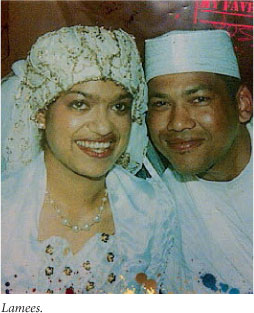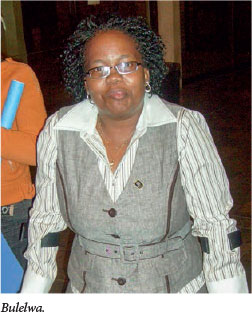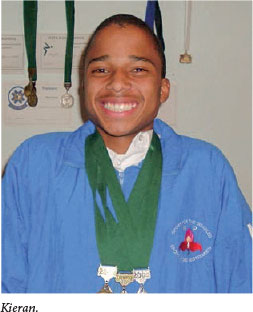Servicios Personalizados
Articulo
Indicadores
Links relacionados
-
 Citado por Google
Citado por Google -
 Similares en Google
Similares en Google
Compartir
SAMJ: South African Medical Journal
versión On-line ISSN 2078-5135
versión impresa ISSN 0256-9574
SAMJ, S. Afr. med. j. vol.104 no.4 Pretoria abr. 2014
CONTINUING MEDICAL EDUCATION
ARTICLES
Beyond the operating theatre: Long-term quality of life in spina bifida
Z Toefy, RN and volunteer
Spinal Defects Clinic, Red Cross War Memorial Children's Hospital, Cape Town, South Africa
ABSTRACT
Long-term quality of life of a person born with spina bifida, as in any disability, is dependent on the challenges of that disability being recognised, met and overcome, to prevent patients becoming handicapped.
It was not a given that I would live.
It was not a given that I would walk.
It was not a given that I would go to school.
It was not a given that I would make it to Matric.
It was not a given that I would get further education.
It was not a given that I would get a job and hold a job.
It was not a given that I would also find love and get married.-
Deoni Oosthuizen, born with spina bifida on 10 January 1972
Challenges
Urine
Urinary incontinence may be one of the most difficult challenges for a person with spina bifida to manage effectively, as leakage and the subsequent odour may cause isolation in the home or workplace.
Incontinence of urine is managed effectively by using a regimen of 3-hourly self-catheterisation, daily bowel washouts and anticholinergic drugs. However, protective clothing, in the form of a full diaper or pad, may still be required for urine or bowel leakage.
Bowel management
Faecal incontinence involves daily bowel washouts by way of water enemas. This process may be difficult to learn, is unpleasant and cumbersome, and may be painful.
The team attending to the person with spina bifida needs to emphasise that successful bowel management means that accidents will happen infrequently and that normal underclothing may be worn.
Pressure sores
Pressure sores are a potential problem where there is diminished sensation, such as the pelvic area or the feet. The potential for developing pressure sores is increased in the pelvic area when urinary incontinence prevails. Pressure sores around the foot may be caused by tight shoes, injuries or burns.
Regular follow-up
A person with spina bifida should be regularly followed up at a hospital for various reasons:
• The renal tract should be examined regularly (ultrasound, urodynamic studies).
• The nursing staff at the clinic have the opportunity to test urine, look for the development of pressure sores, reinforce support with parents/carers, and report problems to the doctors.
• A urologist must assess bladder function, a neurosurgeon if there is a hydrocephalus, an orthopaedic surgeon if there is foot, leg and bony spine involvement, and a paediatrician for school readiness (4- 5-year olds).
• Parents/carers collect their consumables (e.g. catheters, bowel washout bags, medicines, ointments) at the clinic.
It can be difficult for the parent/carer to hold down a job if their employer struggles to understand their need to regularly take time off from work for the needs of the disabled child. Parents of disabled children are financially strained, and the income from a social grant is not sufficient.
Further education and employment
The overall development of a child with spina bifida is affected by physical, emotional, social and intellectual factors, and many children need special schooling and further education. Mainstream schools are reluctant to accept these children as they may be academically challenged and have problems (e.g. incontinence), and widespread stigmatisation is common. Ten years ago it was practically impossible for a young person with spina bifida to find employment. With the advent of Further Education Training (FET) colleges and organisations, such as the Siyaya Skills Institute, there are more opportunities for young people with the condition to enter the open labour market.
The Siyaya Skills Institute
The Siyaya Skills Institute is a pro-active participant and facilitator of the process of unlocking the human resource potential of all South Africans, particularly for people with disabilities and communities that are served through their various business initiatives. The Institute's joint venture partner, Extrinsic (an expert in disability management), assists with all disability programmes and aspects of the learnership process. Extrinsic specialises in the recruitment, management and employment of people with disabilities. Their primary focus is on bulk employment initiatives through vehicles such as learnership and internship programmes. Extrinsic places people with disabilities, based on job specifications.
Their approach to employment consists of three tiers:
• assisting the employer to employ through disability awareness and sensitisation programmes
• employing the person with a disability
• supporting the employee in his/her employment.
Mobility
Access to many buildings and homes, as well as travelling, remains a challenge for a person in a wheelchair or on crutches, conferring the label 'disabled' to such a person. Society needs to adapt in a way that prevents the person from becoming 'handicapped' by the consequences of spina bifida. A person with this condition may not only find it difficult to obtain employment, but, once employed, will also struggle to commute to and from work by public transport. This may well be a concern for the potential employer.
Social integration
While there is ignorance about and prejudice towards people with spina bifida, a person who is disabled by the condition may effectively be 'handicapped' by society. Primary healthcare projects and community-based groups form an essential part of rooting out this misunderstanding and allowing people with the condition to become integrated into society.
Community-based groups can provide the following support:
• Meeting in their immediate community, giving ongoing assistance, advice, and information.
• Sharing hands-on practical assistance with catheterisation and bowel washouts.
• Finding clinic defaulters with the help of the group.
• Empowering the mother, child and family during meetings.
• The empowered mother, entrusted with the management of the child, is so motivated with this aspect of her life that it spills over to other areas of her life, alleviating the stress on the family.
Marriage and family life
The nature of this disability and developmental delay mean that most of these children rely on parental care for a long time, contributing to stressful situations in the family. However, young people less severely affected by spina bifida do marry and live a normal life, as their individual stories illustrate.
Marriage for the disabled person, whether with an able-bodied or disabled partner, has a very different dynamic, particularly pertaining to intimacy. Sex therapists give excellent advice regarding this area of married life. Pregnancy and delivery require very close follow-up and specialist attention.
Successes
Understanding spina bifida and its management is vital. Often parents and carers of these children are uneducated and come from impoverished communities.
Spina bifida patients in rural areas do not benefit from good schooling, owing to the distances they have to travel, particularly using wheelchairs and crutches.
Parents/carers must travel long distances to specialised and comprehensive healthcare services for their child's needs. This often results in defaulting, which leads to deterioration of the child's condition.
While we have praised the successes of some of the people with spina bifida, we also have to discuss the problems of those who don't respond as positively to the treatment and management regimen.
Poor response to treatment and management may have many causes, such as socio-economic and financial constraints, poor living conditions, e.g. no access to clean water. Severe cases of spina bifida with intellectual impairment and major physical disabilities are particularly difficult for most parents to manage.
Personal stories
For World Spina Bifida Day 25 October 2013 we asked 10 adults with spina bifida to send us a photo and a short story of their lives.
Here are some of their stories.
Deoni
Deoni was born on 10 January 1972 with spina bifida and hydrocephalus. Her mother, Cornelia Louw, received very little information from the medical staff. They told her that the baby was born with an oop ruggie (an opening in her spine).

However, Deoni went on to defy all the challenges that face a child born with this disability.
She was a very bright youngster and Cornelia, and father Deon, encouraged her to do most things for herself from a very young age.
She walks with the aid of crutches, and her vetriculoperitoneal shunt has remained patent since she was 6 months old.
She matriculated at Mossel Bay High School and obtained a BA Health Sciences and a Social Services degree from Unisa.
In September 2011 she married Andre Oosthuizen, who became a wheelchair-bound paraplegic after a motor vehicle accident.
Deoni runs her own business from her home in Paarl, teaching study methods to primary schoolchildren.
Lamees
Lamees is 39 years old and was born with spina bifida and hydrocephalus. Her mother Fahiema was not told anything about her baby's condition at the time of her birth. Over the years, with the help of the nursing and medical staff at the clinic she attended, Fahiema gradually learnt more about the condition.
Lamees completed Grade 10 at Eros School and studied clothing production at Northlink College. Unfortunately, she had to discontinue her studies because of financial constraints.
It was at Eros School that she met Shafiek Jaftha, who has mild cerebral palsy. They married and Lamees gave birth to two healthy boys, now 9 and 6 years old. Three years ago, her shunt was revised because she developed headaches and high blood pressure.

Lamees walks with the aid of crutches but finds it much easier to use a wheelchair when going out.
Bulelwa
Every weekend, Bulelwa drives herself in her specially converted car from Vredenberg on the West Coast to her mother's house in Khayelitsha. She was born in 1975 with spina bifida, without hydrocephalus.
At primary school level she attended a school for special needs but attended a mainstream high school where she matriculated. She completed an executive secretarial course at K Commercial College and is now a chief administrator in the information systems department at Transnet in Saldanha Bay.
In 1998, Bulelwa gave birth to a baby boy, who is now 16 years old.
She walked with the aid of crutches, until a hip injury in 2009 forced her to use a wheelchair.
'My spina bifida is not an obstacle on living my life and reaching for my dreams. Whatever I do, my mother supports me, she believes in me, gives me space and allows me to fall.'

Kieran
Kieran is a 25-year-old man born with spina bifida and hydrocephalus in 1989. He does not regard himself as a handicapped person, but rather as one with a disability. His shunt was replaced once at the age of 5 years. He walks with the aid of crutches.
He attended a school for special needs, where he matriculated.
Kieran learnt to swim at a very young age and in 2012 assisted at a school in giving swimming lessons to their learners. He achieved Western Province colours for wheelchair table tennis, athletics, swimming and basketball.
He drives his own specially converted car, and works for a car rental company.
To conclude, a young woman born with spina bifida once said, 'Our background and circumstances may have influenced who we are but we determine who we become.'

 Corresponding author:
Corresponding author:
Z Toefy
(zubeidatoefy@gmail.com)














